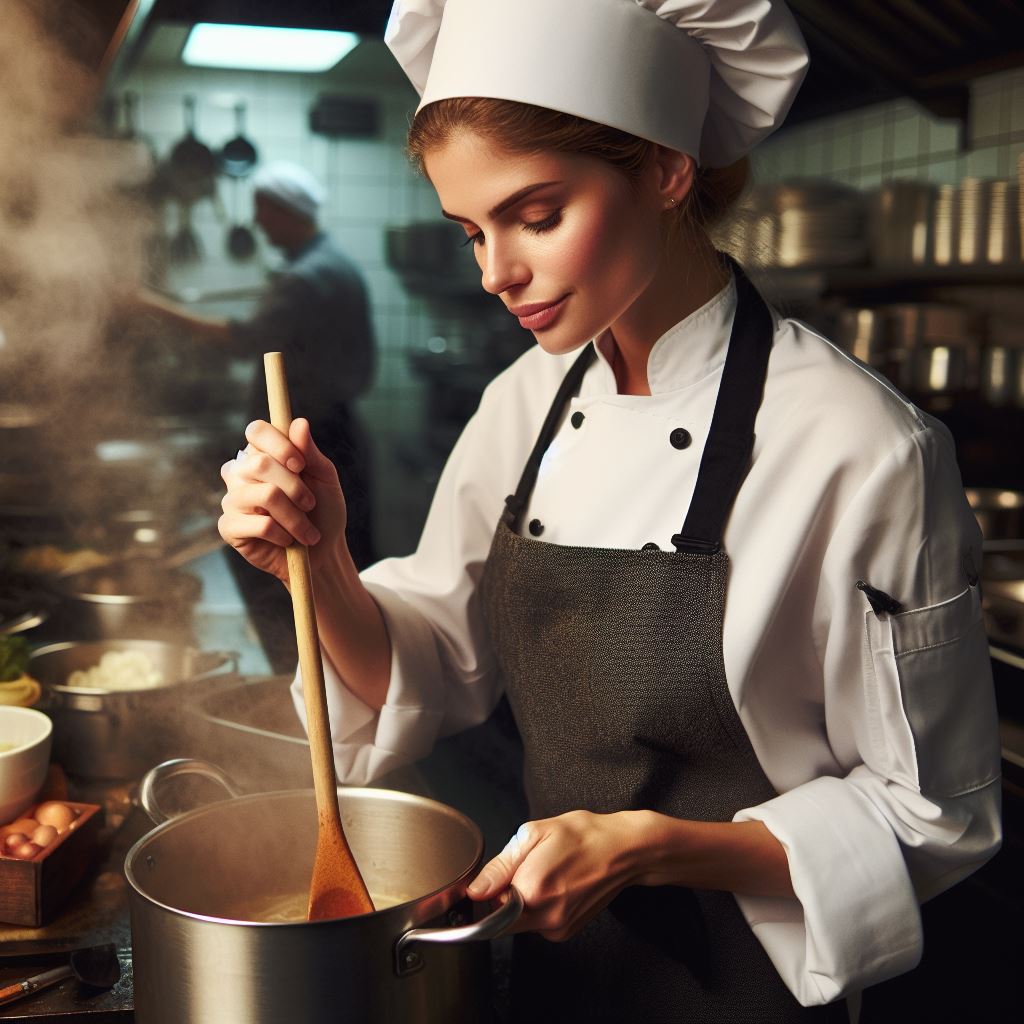Introduction
Understanding culinary trends is crucial for chefs to stay relevant and satisfy evolving customer preferences.
This article explores the insights of top chefs regarding Kiwi culinary trends in 2024.
Importance of Understanding Culinary Trends in the Industry
In the fast-paced culinary industry, keeping up with trends is vital for success.
It allows chefs to anticipate changing customer demands and adapt their menus accordingly.
By embracing new culinary trends, chefs can attract more customers, enhance their reputation, and increase business profitability.
Overview of the Article Structure
This blog chapter will delve into the predictions made by renowned chefs about the culinary landscape in New Zealand for the year 2024.
It will highlight the emerging ingredients, cooking techniques, and dining experiences that are expected to dominate the Kiwi culinary scene.
The post will provide in-depth insights into the trends and transformations that chefs can incorporate into their culinary repertoire, ensuring their continued relevance and success.
By staying ahead of the curve, chefs can tap into the ever-changing consumer preferences and offer innovative and exciting culinary experiences.
With the insights shared by top chefs in this post, fellow culinary enthusiasts can gain inspiration and guidance regarding the upcoming trends in the Kiwi culinary realm.
So, let’s dive into the exciting world of Kiwi culinary trends for 2024 and explore the tastes, flavors, and techniques that will shape the future of New Zealand’s vibrant food industry.
Current Culinary Trends in New Zealand
When it comes to food and culinary trends, New Zealand is at the forefront of innovation and sustainability.
Let’s take a closer look at some of the popular trends that are shaping the Kiwi culinary scene:
1. Locally Sourced Ingredients
- The farm-to-table movement has gained immense popularity in New Zealand.
- Restaurants and chefs are prioritizing locally sourced, seasonal ingredients.
- Farmers markets are thriving, enabling people to access fresh produce directly from the source.
- Consumers are now more conscious about supporting local farmers and reducing food miles.
2. Sustainability and Ethical Practices
- New Zealanders have a deep-rooted connection with their environment.
- Restaurants are implementing sustainable practices, such as reducing food waste and utilizing renewable energy.
- Chefs are focusing on ethical sourcing, ensuring that seafood and meat come from responsible fisheries and farms.
- There is a growing interest in plant-based and vegetarian options, reflecting a more sustainable approach to dining.
3. Incorporation of Māori and Pacific Flavors
- Māori and Pacific influences have made their way into contemporary New Zealand cuisine.
- Chefs are exploring traditional Māori ingredients and cooking techniques.
- Hāngī, a traditional Māori method of cooking in an underground pit oven, is gaining popularity.
- Flavors like kawakawa (native bush basil) and horopito (bush pepper) are being incorporated into dishes.
4. Fusion of Cultures
- New Zealand’s diverse cultural landscape is reflected in its cuisine.
- Restaurants are embracing fusion cooking, blending different culinary traditions and flavors.
- Asian, Indian, and Mediterranean influences are subtly infused into Kiwi dishes.
- This blending of cultures creates a unique and exciting dining experience for locals and tourists alike.
5. Street Food and Food Trucks
- A thriving street food scene has emerged in cities like Auckland and Wellington.
- Food trucks offering a diverse range of cuisines and flavors have become immensely popular.
- People are enjoying quick and delicious meals on the go, without compromising on quality.
- Pop-up food markets and festivals showcase the vibrant street food culture in New Zealand.
New Zealand’s culinary landscape is constantly evolving, driven by a passion for fresh, sustainable ingredients and a celebration of diverse flavors.
With an emphasis on locally sourced produce, sustainability, and the incorporation of Māori and Pacific influences, Kiwi cuisine continues to captivate taste buds and push culinary boundaries.
Personalized Career Consulting
Unlock your potential with expert career advice tailored to your goals. Get personalized guidance and actionable steps toward your dream career in New Zealand.
Get StartedRead: Farm to Table: NZ Chefs on Local Produce
Emerging Trends for 2024
Insights from renowned chefs and industry experts
When it comes to culinary trends, chefs and industry experts are at the forefront of innovation.
They have their fingers on the pulse of what’s new and exciting in the world of food.
So, what can we expect to see in 2024? Here are some insights from renowned chefs and industry experts:
Incorporation of new ingredients
One of the emerging trends for 2024 is the incorporation of new and exotic ingredients into dishes.
Chefs are constantly looking for ways to elevate their creations and surprise diners with unique flavors.
Ingredients like jackfruit, kelp, and halloumi cheese are predicted to dominate the culinary scene.
Flavors from around the world
Another trend that is set to dominate the culinary scene in 2024 is the exploration of flavors from around the world.
Chefs are increasingly embracing diverse cuisines and incorporating global flavors into their menus.
Expect to see dishes inspired by Japanese, Mexican, and Middle Eastern cuisines, among others.
Focus on healthy options
With the growing emphasis on health and wellness, it’s no surprise that healthy options will take center stage in 2024.
Chefs are incorporating more plant-based ingredients and creating dishes that are both nutritious and delicious.
Expect to see an increase in vegan and vegetarian options on menus.
Plant-based alternatives
The popularity of plant-based alternatives is on the rise, and this trend is expected to continue in 2024.
Transform Your Career with a Professional CV and Cover Letter
Stand out to employers with an ATS-optimized resume and tailored cover letter designed to match your dream role. Let us craft your job application materials for success!
Get StartedChefs are experimenting with ingredients like plant-based meats, dairy-free cheeses, and nut milks to create dishes that cater to a wide range of dietary preferences and restrictions.
Sustainable and zero-waste practices
As awareness of environmental issues grows, chefs and restaurants are making efforts to reduce food waste and promote sustainability.
In 2024, expect to see more restaurants adopting zero-waste practices, utilizing sustainable ingredients, and implementing eco-friendly cooking techniques.
Prediction of new ingredients and flavors to dominate the culinary scene
In addition to insights from chefs and industry experts, there are also predictions about new ingredients and flavors that will dominate the culinary scene in 2024.
Here are some of the anticipated trends:
Seaweed and kelp
Seaweed and kelp have gained popularity in recent years due to their umami flavors and nutritional benefits.
These marine ingredients are predicted to become even more prevalent in 2024, appearing in dishes like salads, wraps, and even desserts.
Jackfruit
Jackfruit, a tropical fruit native to Southeast Asia, has been touted as a plant-based meat alternative due to its texture and ability to absorb flavors.
In 2024, expect to see jackfruit used in burgers, tacos, and other savory dishes.
Middle Eastern flavors
Middle Eastern cuisine is gaining popularity for its bold and aromatic flavors.
Dishes like hummus, falafel, and za’atar are expected to make their way into mainstream menus in 2024.
Alternative flours
As more people adopt gluten-free diets, alternative flours like almond, coconut, and chickpea flour are becoming increasingly popular.
In 2024, expect to see these flours being used in a variety of baked goods and other dishes.
Focus on healthy and plant-based options
One of the most significant trends in the culinary world is the focus on healthy and plant-based options.
Boost Your Career with a Standout LinkedIn Profile
Attract recruiters and expand your network with a fully optimized LinkedIn profile tailored to highlight your strengths and professional goals. Let your profile open doors to new opportunities!
Get OptimizedAs consumers become more health-conscious, chefs are responding by creating dishes that are not only delicious but also good for the body.
In 2024, this trend will continue to grow, and more restaurants will emphasize vegan and vegetarian offerings.
So, whether it’s the incorporation of new ingredients, the exploration of global flavors, or the focus on health and sustainability, the culinary scene in 2024 promises to be exciting and diverse.
With insights from renowned chefs and predictions about new flavors and ingredients, there’s no doubt that the future of food is looking bright.
Read: The Future of Fine Dining in New Zealand

Innovation and Technology in the Culinary Field
Technology has become a driving force in the culinary world, influencing trends and revolutionizing traditional cooking practices.
Chefs are continuously exploring new techniques and equipment to enhance their creations and bring unique experiences to the table.
In addition, the rise of social media and digital platforms has transformed the way food is presented and the impact it has on consumer preferences.
1. How technology is influencing culinary trends
Technology has given chefs access to a wide range of innovative tools and techniques that were once unimaginable.
From molecular gastronomy to sous vide cooking, these advancements have revolutionized culinary trends by pushing boundaries and expanding the realm of possibilities.
By embracing technology, chefs can create dishes that are visually stunning and offer unexpected flavors and textures.
With the help of cutting-edge equipment such as immersion circulators, dehydrators, and rotary evaporators, chefs can experiment with different cooking methods and transform ingredients in ways that were previously unattainable.
This allows them to elevate traditional dishes and offer unique dining experiences to customers.
2. Introduction of new cooking techniques and equipment
Chefs are constantly seeking out innovative ways to enhance their culinary creations.
The introduction of new cooking techniques and equipment has become a key aspect of culinary trends.
For example, precision cooking techniques like sous vide have gained popularity among chefs for their ability to deliver consistent results and retain flavors.
Furthermore, the integration of technology in kitchen appliances has drastically improved efficiency.
Smart ovens and induction cooktops offer precise temperature control and minimize energy consumption.
In addition, the development of robotic kitchen assistants and automated cooking systems has streamlined kitchen operations, allowing chefs to focus on creativity and presentation.
3. Impact of social media and digital platforms on food presentation and consumer influence
The advent of social media and digital platforms has transformed the way food is presented and consumed.
Platforms like Instagram and Pinterest have become influential spaces for chefs to showcase their creations and connect with an audience on a global scale.
The visual nature of these platforms has driven a significant shift in food presentation.
Chefs are now mindful of creating visually appealing dishes that are “Instagrammable.”
This has led to the emergence of trends like elaborate plating techniques, colorful ingredients, and edible garnishes.
Food presentation has become an art form in itself, with chefs carefully crafting dishes that are not only delicious but also visually captivating.
Furthermore, social media has empowered consumers to become more influential in shaping culinary trends.
Through user-generated content, reviews, and recommendations, individuals have the power to impact the success or failure of restaurants and food establishments.
Chefs are now more attentive to customer feedback and preferences, and are using social media as a tool to engage with their audience and understand their evolving tastes.
The culinary field is experiencing a technological revolution that is reshaping the way chefs conceptualize and create their dishes.
Through the integration of cutting-edge tools and techniques, chefs can push boundaries and offer unique dining experiences.
Additionally, social media and digital platforms have emerged as powerful channels for showcasing culinary creativity and engaging with consumers.
As technology continues to advance and consumer preferences evolve, it is clear that the culinary world will continue to be influenced by innovation and digital platforms.
The future of gastronomy holds exciting possibilities for both chefs and food enthusiasts, promising a culinary landscape that is driven by creativity, technology, and consumer influence.
Read: Meet NZ’s Award-Winning Female Chefs
Regional Differences in Culinary Trends
When it comes to culinary trends in New Zealand, different regions showcase unique food preferences and cultural influences.
Let’s explore how regional differences shape the gastronomic landscape of the country.
Unique Food Trends
Each region in New Zealand has its own distinctive food trends that reflect the local produce and cultural heritage.
These trends vary from the North Island to the South Island and even within different cities.
For example, in Wellington, the capital city, there is a growing trend of modern fusion cuisine that combines traditional Māori ingredients with international flavors.
This unique blend creates innovative dishes that are both visually appealing and delicious.
On the other hand, in Auckland, the largest city in New Zealand, there is a growing interest in Asian cuisine due to its diverse population.
Japanese ramen, Korean barbecue, and Thai street food have become increasingly popular among the locals, reflecting the influence of cultural diversity on food preferences.
Influence of Cultural Diversity
The cultural diversity in New Zealand, shaped by the influx of immigrants from various countries, has a significant impact on the culinary preferences across the regions.
The fusion of different cultural backgrounds has resulted in a dynamic food scene with a wide range of options.
In regions with a strong presence of Māori culture, indigenous ingredients such as kawakawa leaves, kūmara (sweet potato), and kina (sea urchin) are incorporated into traditional dishes.
This not only preserves the heritage but also adds a unique flavor profile to the cuisine.
Similarly, the Chinese community has influenced the culinary landscape, particularly in cities like Wellington and Christchurch.
Chinese dumplings, noodles, and stir-fried dishes have become popular, merging with local ingredients to create exciting new flavors.
Examples of Popular Regional Dishes
In the North Island, Rotorua stands out for its traditional hangi, a method of cooking food in an earth oven.
This communal feast includes succulent meats, vegetables, and steamed pudding, all slow-cooked underground for a distinctive smoky flavor.
Moving to the South Island, the city of Dunedin showcases the renowned Otago lamb.
The region’s pristine pastures and mild climate result in high-quality grass-fed lamb that is favored by both locals and tourists.
Another regional dish worth mentioning is the Bluff oysters from Bluff, a small fishing village in the Southland region.
These plump, creamy oysters are considered a delicacy in New Zealand and are celebrated annually at the Bluff Oyster Festival.
In general, regional differences play a significant role in shaping culinary trends in New Zealand.
The unique food trends, influenced by cultural diversity, make each region a food lover’s paradise.
From fusion cuisine to traditional indigenous dishes, exploring the regional culinary delights is a must for any food enthusiast visiting the country.
Read: Sustainable Cooking: NZ Chefs Leading Change
Impact of Tourism on Kiwi Culinary Trends
The tourism industry plays a significant role in shaping culinary trends in New Zealand.
With an increasing number of international visitors flocking to experience the beauty and adventure that the country offers, it is crucial for the food industry to provide authentic experiences that reflect the local culture and cuisine.
This blog post explores the impact of tourism on Kiwi culinary trends and showcases examples of how the food industry adapts to meet the demands of international visitors.
How tourism affects the food industry in New Zealand
- Tourism brings exposure to unique food experiences and influences the local culinary scene.
- Increased visitor numbers create a demand for diverse dining options and high-quality cuisine.
- Food producers and restaurants benefit from increased business, leading to economic growth.
- Tourism drives innovation in the food industry as businesses aim to stand out from competitors.
- The exchange of culinary ideas between tourists and locals enhances cultural understanding.
In the presence of tourism, the food industry in New Zealand experiences growth, as both the demand for local cuisine and the availability of diverse dining options increase.
Importance of offering authentic experiences to international visitors
- Authentic culinary experiences create a lasting impression and contribute to positive word-of-mouth.
- Showcasing local ingredients, traditional cooking methods, and cultural nuances builds a sense of place.
- Visitors seeking unique experiences are willing to pay a premium for authentic Kiwi cuisine.
- Authentic food experiences contribute to the preservation of local traditions and heritage.
- Reputation as a food destination attracts a larger number of culinary enthusiasts.
By offering authentic culinary experiences, New Zealand can position itself as more than just a picturesque destination but also as a culinary hotspot.
It creates a win-win situation, where visitors get to explore the local cuisine while contributing to the growth of the food industry.
Examples of tourism-driven culinary trends and their impact on local food businesses
- Street food markets have gained popularity, providing a platform for local vendors to showcase their dishes.
- Restaurants are incorporating indigenous ingredients like kawakawa and horopito into their menus.
- Food tours and cooking classes focused on traditional Maori cuisine are on the rise.
- Farm-to-table concepts are thriving, emphasizing the importance of fresh and locally sourced ingredients.
- Pop-up dining experiences featuring fusion cuisine are attracting both tourists and locals.
These tourism-driven culinary trends have a direct impact on local food businesses.
They create new opportunities for vendors, inspire innovation in menu offerings, and encourage collaborations between different players in the industry.
Additionally, they contribute to the overall reputation of New Zealand as a vibrant and dynamic culinary destination.
In a nutshell, tourism plays a crucial role in influencing Kiwi culinary trends.
The demand for authentic experiences from international visitors drives innovation and economic growth in the food industry.
By showcasing local cuisine and embracing cultural traditions, New Zealand can continue to attract a growing number of culinary enthusiasts and position itself as a must-visit destination for food lovers.
Conclusion
It is essential to recap the key insights we have discussed.
The culinary scene in New Zealand is continually evolving, and it is crucial for chefs and food enthusiasts to stay updated to remain relevant.
We have highlighted the rise of sustainable and locally sourced ingredients, the growing popularity of plant-based and vegan options, and the incorporation of indigenous Maori flavors and cooking techniques.
These trends reflect the changing preferences and values of consumers.
Adapting to these culinary trends is not only important for chefs and restaurateurs but also for anyone who appreciates good food.
Exploring the Kiwi culinary culture allows us to embrace diversity and experience new flavors that go beyond traditional boundaries.
It is a thrilling time for food lovers in New Zealand, as the culinary scene continues to flourish and surprise us with innovative and exciting dishes.
By keeping up with the latest trends and trying out new restaurants and food experiences, we can truly appreciate the uniqueness of Kiwi cuisine.
So, whether you are a seasoned chef, a local foodie, or a curious traveler, take the opportunity to explore the Kiwi culinary culture.
Discover the hidden gems, indulge in the local delicacies, and embrace the flavors that define New Zealand’s vibrant food scene.




